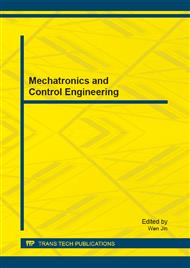[1]
L. Pavel, "Dynamics and stability in optical communication networks: A system theoretic framework," Automatica, vol. 40, no. 8, 2004, p.1361–1370 (1982).
DOI: 10.1016/j.automatica.2004.03.014
Google Scholar
[2]
J. L. Zyskind, et al., "Fast power transients in optically amplified multiwavelength optical networks," Proc. OFC'96, 1996, Paper PD31.
Google Scholar
[3]
A. K. Srivastava, Y. Sun, J. L. Zyskind, and J. W. Sulhoff, " EDFA transient response to channel loss in WDM transmission system," IEEE Photon. Technol. Lett., vol. 9, no. 3, Mar. 1997, p.386–388.
DOI: 10.1109/68.556082
Google Scholar
[4]
Y. Sun et al., "Fast power transients in WDM optical networks with cascaded EDFAs," Electron. Lett., vol. 33, no. 4, 1997, p.313–314.
DOI: 10.1049/el:19970187
Google Scholar
[5]
M. Zirngibl, "Gain control in erbium-doped fiber amplifiers by all-optical feedback loop," Electron. Lett., vol. 27, no.7, 1991 , pp.560-561
DOI: 10.1049/el:19910353
Google Scholar
[6]
E. Desurvire, Erbium Doped Fiber Amplifiers: Principles and Applications. New York: Wiley, 1994.
Google Scholar
[7]
A. V. Tran, C. J. Chae, R. S. Tucker, and Y. J. Wen,"EDFA transient control based on envelope detection for optical burst switched networks," IEEE Photon. Technol. Lett., vol. 17, no. 1, Jan. 2005, p.226–228.
DOI: 10.1109/lpt.2004.837736
Google Scholar
[8]
A. K. Srivastava, et al., "Fast-link control protection of surviving channels in multi-wavelength optical networks," IEEE Photon. Technol. Lett., vol. 9, no. 12, Dec. 1997, p.1667–1669.
DOI: 10.1109/68.643307
Google Scholar
[9]
S. Shin, D. Kim, S. Kim, S. Lee, and S. Song, "A novel technique to minimize gain-transient time of WDM signals in EDFA," J. Opt. Soc. Korea, vol. 10, no. 4, 2006, pp.174-177.
DOI: 10.3807/josk.2006.10.4.174
Google Scholar
[10]
S. Kim, H. T. Choi, W. K. Chung, and I. H. Suh, "Analysis and design of robust motion controllers in the unified framework," Journal of Dynamic Systems, Measurement, and Control, vol. 124, 2002, pp.313-321.
DOI: 10.1115/1.1468995
Google Scholar
[11]
K. K. Kokotovic, H. Khalil, and J. Orelly, Singular perturbation method in control, SIAM, 1987.
Google Scholar


